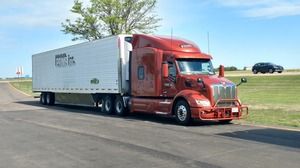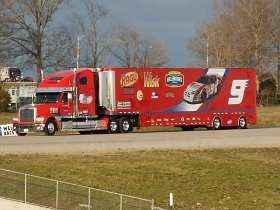Prime Vs Knight Vs Jim Palmer/Wil Trans
Topic 21827 | Page 1
Prime and Jim Palmer/Wiltrans have the same training. They start paying quickly. The first payments are an advance that will be payroll deducted until paid back. I don't know about Knight which is now part of Swift or the other way around. If I had to choose just between those, I would go with Prime.
Since I was trained by and work for CFI, I can tell you more about them and their training. You would need your permit and DOT medical card before going to training. They will pay you back for that. (Keep receipts) You will not have to pay for anything during your four weeks of training. Once you pass your CDL test, you go back to Joplin for 4 days of orientation. You get paid $100.00 cash for that. Once you go out with your trainer/finisher, you get paid 22 CPM. You will drive at least 7500 miles with your trainer. This usually takes about 3 weeks. You are dispatched as a solo truck, so you are expected to do all the driving. We have alot of freight going in and out of California. Also, when you go home you will take your truck and trailer. You will have to find a place to park it. I don't where our drop yards are in Southern California. If you you lived close enough to one you could end up bobtailing home.
Every company works different, so it is best to check with each. Here is a link to threads with questions to ask recruiters. Go through those and pick the ones that matter to you. Good luck.
CDL:
Commercial Driver's License (CDL)
A CDL is required to drive any of the following vehicles:
- Any combination of vehicles with a gross combined weight rating (GCWR) of 26,001 or more pounds, providing the gross vehicle weight rating (GVWR) of the vehicle being towed is in excess of 10,000 pounds.
- Any single vehicle with a GVWR of 26,001 or more pounds, or any such vehicle towing another not in excess of 10,000 pounds.
- Any vehicle, regardless of size, designed to transport 16 or more persons, including the driver.
- Any vehicle required by federal regulations to be placarded while transporting hazardous materials.
Bobtail:
"Bobtailing" means you are driving a tractor without a trailer attached.
DOT:
Department Of Transportation
A department of the federal executive branch responsible for the national highways and for railroad and airline safety. It also manages Amtrak, the national railroad system, and the Coast Guard.
State and Federal DOT Officers are responsible for commercial vehicle enforcement. "The truck police" you could call them.
CPM:
Cents Per Mile
Drivers are often paid by the mile and it's given in cents per mile, or cpm.
HOS:
Hours Of Service
HOS refers to the logbook hours of service regulations.OOS:
When a violation by either a driver or company is confirmed, an out-of-service order removes either the driver or the vehicle from the roadway until the violation is corrected.

Ronald M.,
Prime has a drop yard in Fontana. Hopefully that will make your decision a little easier. I don't get out to CA too often here of late, but maybe that will help with your decision knowing that little piece of information.
Ernie
OWI:
Operating While Intoxicated

Ronald M.,
Prime has a drop yard in Fontana. Hopefully that will make your decision a little easier. I don't get out to CA too often here of late, but maybe that will help with your decision knowing that little piece of information.
Ernie
By having a drop yard I'm assuming that only means I can drop off my trailer there. Where would I park my tractor. I live in an apartment so there is no way I'd be able to park my truck on this street due to their being signs of no commercial vehicles over 6000 lbs. :(
OWI:
Operating While Intoxicated
Most drop yards are also for tractors, too. They're used by local drivers at the end of a shift, as well as drivers on hometime (days off).

I work for Prime as well and I dont get to California much at all. I get turned around at wyoming, idaho, nebraska, missouri, and illinois. I zeroed in on hometime with your post. Its a lovely paradox hometime, in my limited experience in trucking and my experience with prime specifically I can say this. If you go OTR , hometime will kill your paychecks because you dont get paid for that time. If you go home every three weeks for 3 days which is primes bare minimum you will effectively work 324 days a year give or take. With that I worked somewhere around 350 days this year and I am on track to make about 58k this year as my first year in trucking with Prime. Also coming off hometime and going home for hometime are weeks notorious for lower mileage due to logistics of getting you home on your preferred day. This means they wont be high mileage weeks either, so boiling it down, that will lower your gross pay for the year. Simple terms the more hometime the less money you will make, and Prime isnt set up for plentiful hometime. I work 6 weeks take off 4 days just to give you perspective. This isnt meant for discouragement but as info for you to make a more informed choice.
shiny side up
Christian
OTR:
Over The Road
OTR driving normally means you'll be hauling freight to various customers throughout your company's hauling region. It often entails being gone from home for two to three weeks at a time.
Just another consideration Jim Palmer /Wil Trans pulls Primes freight. There home time policies are pretty much the same. Pay is similar. Biggest difference is Jim Palmer / Wil Trans use black Freightliner Cascadias with 72" sleeper & Peterbilt 579s. I am not sure if the Petes are 72" or 80" sleepers. So you won't hear anything about taking a lightweight with them. Pay scales are similar though.
Prime does have a western 11 regional. how hard it is to get on it, that i dont kmow. ask the recruiter. i met a few of our drivers who run a lot of local stuff from fontana as well.
ask, it wouldnt hurt.
Regional:
Regional Route
Usually refers to a driver hauling freight within one particular region of the country. You might be in the "Southeast Regional Division" or "Midwest Regional". Regional route drivers often get home on the weekends which is one of the main appeals for this type of route.
New Reply:
New! Check out our help videos for a better understanding of our forum features

















Preview:








 TT On Facebook
TT On Facebook
So I submitted my full applications to a lot of trucking companies that offered cdl training. I wasn't expecting to hear back from so many. Now I'm overwhelmed with phone calls and have narrowed my decisions down to these unless anyone knows of any in Southern California.
For me it ultimately comes down to getting paid during training and home time. I live in Whittier so it's not like I can bobtail and park my truck at my house so I'm confused how that works even if I go to Fontana.
CDL:
Commercial Driver's License (CDL)
A CDL is required to drive any of the following vehicles:
Bobtail:
"Bobtailing" means you are driving a tractor without a trailer attached.
BMI:
Body mass index (BMI)
BMI is a formula that uses weight and height to estimate body fat. For most people, BMI provides a reasonable estimate of body fat. The BMI's biggest weakness is that it doesn't consider individual factors such as bone or muscle mass. BMI may:
It's quite common, especially for men, to fall into the "overweight" category if you happen to be stronger than average. If you're pretty strong but in good shape then pay no attention.